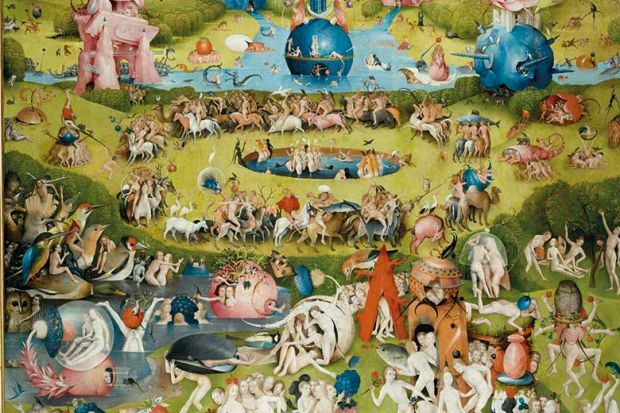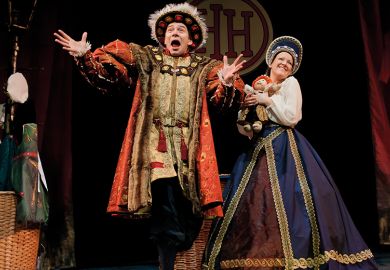"Nothing but devils, buttocks and cod-pieces,” declared 17th-century Spanish poet Francisco de Quevedo on the paintings of Hieronymus Bosch. Undaunted, Joseph Leo Koerner pairs Bosch with his fellow Netherlandish artist Pieter Bruegel the Elder in a bid to prove that they were the inaugural masters of secular genre paintings, paintings of everyday life.
Bosch and Bruegel lived in Brabant when the Low Countries were under Catholic Habsburg rule from Spain; these were dangerous times of developing Reformation and violent Spanish efforts to crush heresy with war and Inquisition. In emerging Protestant iconoclasm, images themselves were physically attacked. It grew safer for artists to tackle secular subjects rather than traditional religious material.
Based on Koerner’s 2008 A. W. Mellon Lectures, this book is a lucid and rewarding read, and lavishly illustrated with 325 reproductions (although it would have been useful to have artwork dimensions, a list of illustrations and a bibliography). Ruminating on works including Bosch’s Adoration of the Magi (c.1510) and The Garden of Delights (1504), Bruegel’s Winter Landscape with Bird Trap (1565) and The Peasant and the Bird Thief (1568), Koerner carefully advances his interpretations. Historical context, other artists’ work and the evidence of copies and engravings are utilised as Koerner probes layers of meaning in these complex artworks. His use of illustration details from the paintings is particularly effective.
Both artists use vast planes, with an array of mesmerising details, to captivate and “overload our sense of sight, entangle our eye, ensnare us in enigmas”. Bosch’s ethereality contrasts with Bruegel’s stolid down-to-earthness. Bosch depicts a diabolical enemy at war with God, while Bruegel is unremittingly focused on the human. Koerner navigates deftly through fraught attributions and interpretative controversies. He argues convincingly that Bosch’s depictions of cosmic hostility between God and Devil, “enemy paintings”, became the unlikely cradle of the painting of everyday life.
Bosch creates “pictures of a world that never was or ever could be”. Koerner’s discussion of Romanesque grotesque sculpture and Bosch’s compelling organic monsters is illuminating. Koerner describes how The Garden of Delights (pictured) was commissioned by the Burgundian overlords of Brabant for their pleasure palace in Brussels, and coveted by their enemy, the Spanish Duke of Alba. The painting arrived in Spain in 1593 after Alba had brutally tortured William of Orange’s concierge to reveal its hiding place. Bosch’s triptych “stands apart from the entire Netherlandish tradition”, Koerner observes. Its jewel-like brilliance, the delectation of the picture, “draws us like bees to blossom”. Bosch depicts lust as a verdant garden, bursting with seedpods and oversexed humanity. Figures swarm in a vast amorphous space, with birds, fruits and shellfish. We see “scores of tiny eyes looking at us looking at their cavortings”.
Bruegel creates an atlas of human culture with scenes of peasant revelry and seasonal labour, where village existence appears as an enclave of timelessness. Koerner emphasises the “marked presentism” of Bruegel’s art, how he thrusts us into life’s midst, precariously balances us “on future’s fluid brink”. With Koerner, the reader steps into these scenes. The views these paintings offer “so far exceed our capacity to look that we can never feel finished looking”.
Referencing the Low Countries in his metaphor, Koerner compares analysing Bosch and Bruegel to “looking for a watershed in marshland”, and he does an admirable job of it.
Tracey Warr is research associate in fine art, Oxford Brookes University, and co-editor of Remote Performances in Nature and Architecture (2015).
Bosch and Bruegel: From Enemy Painting to Everyday Life
By Joseph Leo Koerner
Princeton University Press, 448pp, £48.95
ISBN 9780691172286
Published 7 December 2016
Register to continue
Why register?
- Registration is free and only takes a moment
- Once registered, you can read 3 articles a month
- Sign up for our newsletter
Subscribe
Or subscribe for unlimited access to:
- Unlimited access to news, views, insights & reviews
- Digital editions
- Digital access to THE’s university and college rankings analysis
Already registered or a current subscriber? Login




